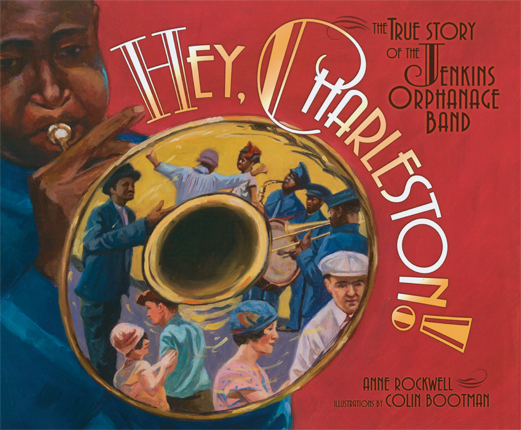Full Text Reviews: School Library Journal - 09/01/2013 Gr 2–5—"Hey, Charleston!… Give us some rag!" yelled the street corner crowd some 100 years ago when Reverend Daniel Joseph Jenkins, former slave and orphan himself, founded the Jenkins Orphanage Band. It all began one night in Charleston, South Carolina, when he discovered several hungry, homeless children near the railroad tracks. He fed them and let them sleep in his church. Word traveled fast and soon more orphans came knocking. The Reverend asked city officials for an empty warehouse, which they granted along with $100, but it was unexpectedly noisy-inmates at the neighboring prison banged on the windows and swore all day. Singing with the boys helped mask the unholy racket, but Jenkins thought to collect old Civil War band instruments and hire music teachers, and soon the orphans were playing "rag" to raise money to fund the pastor's dream: a farm where they could grow their own food and be self-sufficient. The boys were descendants of the Gullah people from West Africa, brought to South Carolina as slaves. They played old band songs African style, twisting, twirling, tapping, knocking their knees, and flapping their arms. They became famous enough to play at Teddy Roosevelt's inauguration and were invited to London to perform. When war broke out in 1914, they secured tickets to return to the States in safety and even paid for other stranded Americans' safe return. Rockwell's informative text is lively and accessible, and Bootman's realistic, full-spread paintings capture the era and energy of the musicians and onlookers dancing and clapping to the beat. Use this inspiring tale for jazz units or African American History Month.—Barbara Auerbach, New York City Public Schools - Copyright 2013 Publishers Weekly, Library Journal and/or School Library Journal used with permission. Booklist - 11/01/2013 This is the little-known story of how Charleston, South Carolina, orphans formed a band and gave America “rag” music. When Reverend Daniel Joseph Jenkins discovered orphans huddled by train tracks in the late 1800s, he took them in, understanding their lives better than most, as he had been an orphan himself. More and more orphans showed up at his church, and soon the Reverend had plenty of mouths to feed. A hundred dollars from city officials led to the purchase of a warehouse, but the prisoners next door made a racket. That’s when Jenkins had an idea: collect old Civil War musical instruments, once used by marching bands, to form the Jenkins Orphanage Band and raise money to buy a farm for the orphans. Soon the band was playing on street corners; many of the kids descended from Geechee or Gullah (the islands around Charleston) and played a style of music called rag. Over the course of the picture book, which covers a lot of territory quickly, the band travels, even to Europe. A fascinating piece of history, complemented by Bootman’s hazy full-bleed paintings. - Copyright 2013 Booklist. Bulletin for the Center... - 12/01/2013 Near the end of the nineteenth century, Reverend Daniel Jenkins began his ministry to the children of Charleston, South Carolina by offering shelter in his church to a handful of orphans. Charitable donations allowed him to house more boys in a larger facility, but to make the orphanage self-sustaining, Jenkins hit upon the idea to organize the boys into a band, with donated instruments and first-rate instructors. Eventually their jazzy style, infused with rhythms and dance steps from the Gullah culture many of the boys descended from, caught the attention of Theodore Roosevelt, who invited the band to play at his inaugural parade. The group eventually went international, playing in London in the opening days of World War I. Though they were fortunate to get home themselves, the band shared a significant portion of their performance profits with other stranded Americans whose financial assets had been frozen while they were overseas. Rockwell’s retelling of the early years of the Jenkins Orphanage Band has been somewhat compressed, and the feel-good mood of the true rags (sartorial and musical)-to-riches tale depends on ignoring the fact that they were not an immediately beloved, overnight success. Bootman’s atmospheric paintings, with individuated faces, almost photographic faces, convey a sense of the excitement that this new style of pop music caused, particularly in the white audiences who embraced it. An author’s note and brief bibliography are included, but google the Fox Movietone Newsreel film and audio performance clips for a jazz unit or a dazzled-up book talk. EB - Copyright 2013 The Board of Trustees of the University of Illinois. Loading...
|



